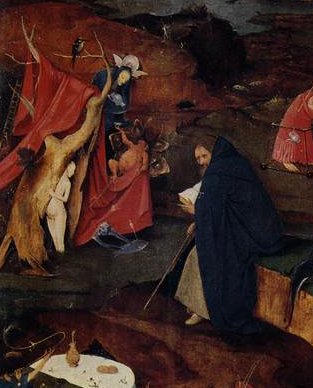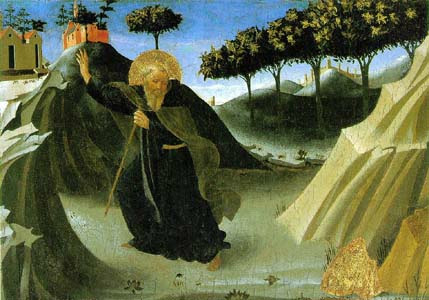|
St. Anthony |
|
|
|
|
|
The best known images of St. Anthony are entitled 'The Temptation of St
Anthony'. They show the saint under attack from hordes of devilish
monsters. These pictures are dealt with under 'torments' here.
This page look at some of the specific temptations mentioned by Athanasius. |
|
|
|
|
|
|
|
| 'And the devil, unhappy wight, one night even took upon him the shape of a woman and imitated all her acts simply to beguile Anthony. But he, his mind filled with Christ and the nobility inspired by Him, and considering the spirituality of the soul, quenched the coal of the other's deceit.' (Athanasius Chapter 5) These temptations are reminiscent of the lustful thoughts that plagued St Jerome years later in a different desert. The temptation in the scenes from the Scenes From the Life sequence is modest looking: Jan Wellens de Cock expanded the tale and provided a whole bevy of rather forward-looking ladies. |
|
|
|
|
| These paintings show Anthony being tempted with a pile of gold.
'Then
again as he went on he saw what was this time not visionary, but real
gold scattered in the way. But
whether the devil showed it, or some better power to try the athlete and
show the Evil One that Anthony truly cared nought for money, neither he
told nor do we know. But it is certain that that which appeared was gold.
And Anthony marvelled at the quantity, but passed it by as though
he were going over fire; so he did not even turn, but hurried on at a
run to lose sight of the place. ' (Athanasius Chapter 5) |
|
For an extended extract from Athanasius on temptations, click here. The writings of Athanasius suggest an idea of temptation very different to our modern view. Reading his text, and looking at the paintings inspired by them, suggests that temptation comes from elsewhere, and is not the responsibility of the person tempted - ‘It was all the Devil’s fault, guv, nothing to do with me.’ This all seems rather naïve, but I think Athanasius was probably little more sophisticated than that. The graphic images of torment and temptation are metaphors dealing with the conflict between the physical and spiritual, original sin that can be overcome by faith. It needs a better theologian than I am to explore this idea further – I’d better stop there!
|
|




